Bardia Yousefi
Density-based Isometric Mapping
Mar 04, 2024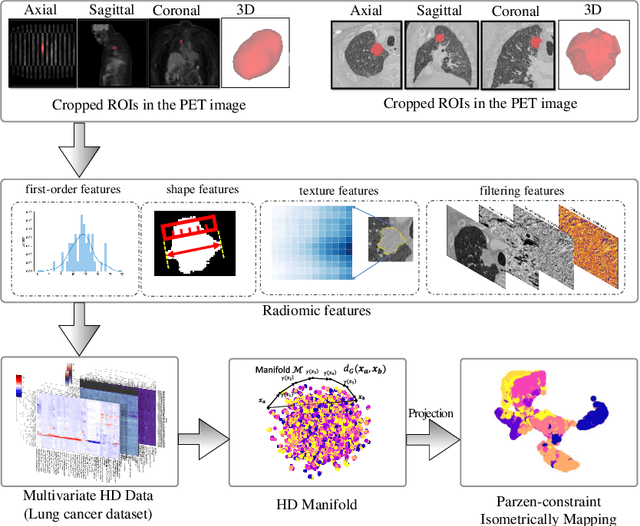
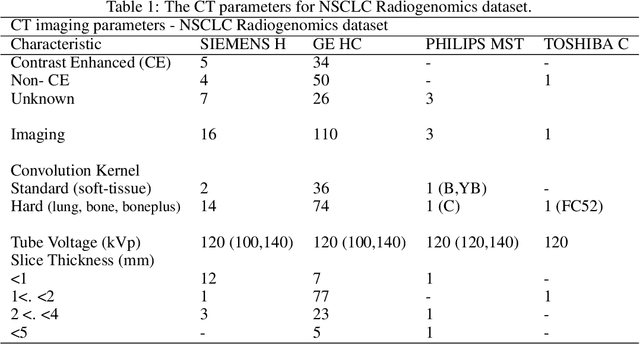
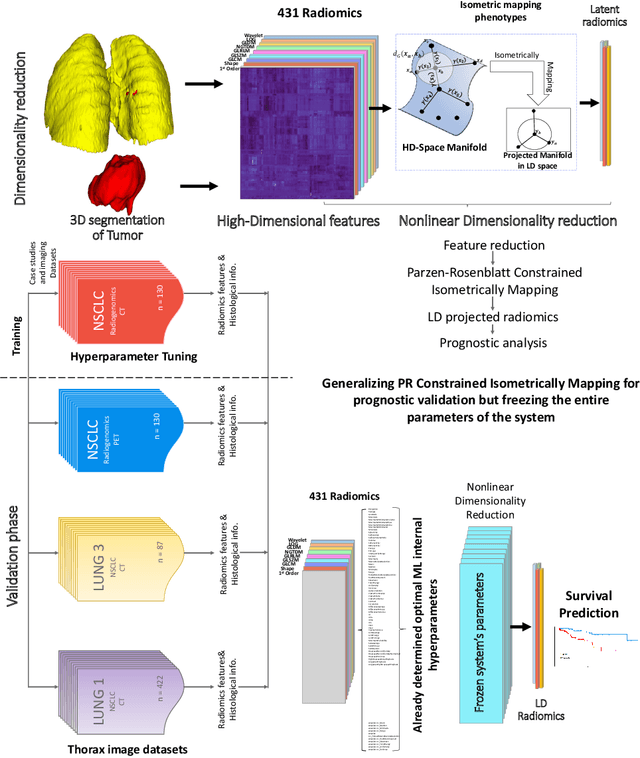
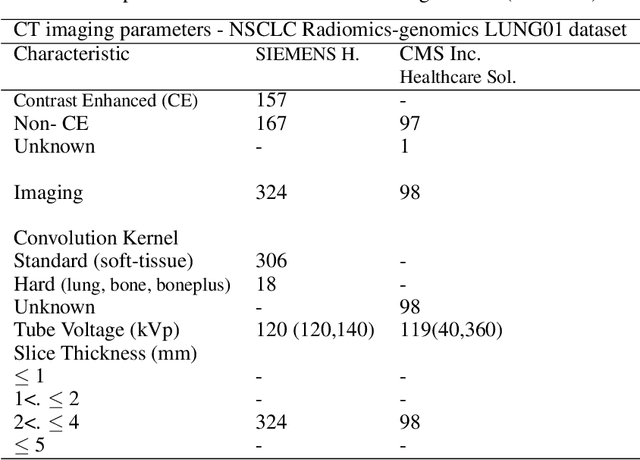
Abstract:The isometric mapping method employs the shortest path algorithm to estimate the Euclidean distance between points on High dimensional (HD) manifolds. This may not be sufficient for weakly uniformed HD data as it could lead to overestimating distances between far neighboring points, resulting in inconsistencies between the intrinsic (local) and extrinsic (global) distances during the projection. To address this issue, we modify the shortest path algorithm by adding a novel constraint inspired by the Parzen-Rosenblatt (PR) window, which helps to maintain the uniformity of the constructed shortest-path graph in Isomap. Multiple imaging datasets overall of 72,236 cases, 70,000 MINST data, 1596 from multiple Chest-XRay pneumonia datasets, and three NSCLC CT/PET datasets with a total of 640 lung cancer patients, were used to benchmark and validate PR-Isomap. 431 imaging biomarkers were extracted from each modality. Our results indicate that PR-Isomap projects HD attributes into a lower-dimensional (LD) space while preserving information, visualized by the MNIST dataset indicating the maintaining local and global distances. PR-Isomap achieved the highest comparative accuracies of 80.9% (STD:5.8) for pneumonia and 78.5% (STD:4.4), 88.4% (STD:1.4), and 61.4% (STD:11.4) for three NSCLC datasets, with a confidence interval of 95% for outcome prediction. Similarly, the multivariate Cox model showed higher overall survival, measured with c-statistics and log-likelihood test, of PR-Isomap compared to other dimensionality reduction methods. Kaplan Meier survival curve also signifies the notable ability of PR-Isomap to distinguish between high-risk and low-risk patients using multimodal imaging biomarkers preserving HD imaging characteristics for precision medicine.
AI-Enabled Lung Cancer Prognosis
Feb 12, 2024Abstract:Lung cancer is the primary cause of cancer-related mortality, claiming approximately 1.79 million lives globally in 2020, with an estimated 2.21 million new cases diagnosed within the same period. Among these, Non-Small Cell Lung Cancer (NSCLC) is the predominant subtype, characterized by a notably bleak prognosis and low overall survival rate of approximately 25% over five years across all disease stages. However, survival outcomes vary considerably based on the stage at diagnosis and the therapeutic interventions administered. Recent advancements in artificial intelligence (AI) have revolutionized the landscape of lung cancer prognosis. AI-driven methodologies, including machine learning and deep learning algorithms, have shown promise in enhancing survival prediction accuracy by efficiently analyzing complex multi-omics data and integrating diverse clinical variables. By leveraging AI techniques, clinicians can harness comprehensive prognostic insights to tailor personalized treatment strategies, ultimately improving patient outcomes in NSCLC. Overviewing AI-driven data processing can significantly help bolster the understanding and provide better directions for using such systems.
* This is the author's version of a book chapter entitled: "Cancer Research: An Interdisciplinary Approach", Springer
Distribution-based Low-rank Embedding
Dec 29, 2023Abstract:The early detection of breast abnormalities is a matter of critical significance. Notably, infrared thermography has emerged as a valuable tool in breast cancer screening and clinical breast examination (CBE). Measuring heterogeneous thermal patterns is the key to incorporating computational dynamic thermography, which can be achieved by matrix factorization techniques. These approaches focus on extracting the predominant thermal patterns from the entire thermal sequence. Yet, the task of singling out the dominant image that effectively represents the prevailing temporal changes remains a challenging pursuit within the field of computational thermography. In this context, we propose applying James-Stein for eigenvector (JSE) and Weibull embedding approaches, as two novel strategies in response to this challenge. The primary objective is to create a low-dimensional (LD) representation of the thermal data stream. This LD approximation serves as the foundation for extracting thermomics and training a classification model with optimized hyperparameters, for early breast cancer detection. Furthermore, we conduct a comparative analysis of various embedding adjuncts to matrix factorization methods. The results of the proposed method indicate an enhancement in the projection of the predominant basis vector, yielding classification accuracy of 81.7% (+/-5.2%) using Weibull embedding, which outperformed other embedding approaches we proposed previously. In comparison analysis, Sparse PCT and Deep SemiNMF showed the highest accuracies having 80.9% and 78.6%, respectively. These findings suggest that JSE and Weibull embedding techniques substantially help preserve crucial thermal patterns as a biomarker leading to improved CBE and enabling the very early detection of breast cancer.
Embedded Deep Regularized Block HSIC Thermomics for Early Diagnosis of Breast Cancer
Jun 03, 2021



Abstract:Thermography has been used extensively as a complementary diagnostic tool in breast cancer detection. Among thermographic methods matrix factorization (MF) techniques show an unequivocal capability to detect thermal patterns corresponding to vasodilation in cancer cases. One of the biggest challenges in such techniques is selecting the best representation of the thermal basis. In this study, an embedding method is proposed to address this problem and Deep-semi-nonnegative matrix factorization (Deep-SemiNMF) for thermography is introduced, then tested for 208 breast cancer screening cases. First, we apply Deep-SemiNMF to infrared images to extract low-rank thermal representations for each case. Then, we embed low-rank bases to obtain one basis for each patient. After that, we extract 300 thermal imaging features, called thermomics, to decode imaging information for the automatic diagnostic model. We reduced the dimensionality of thermomics by spanning them onto Hilbert space using RBF kernel and select the three most efficient features using the block Hilbert Schmidt Independence Criterion Lasso (block HSIC Lasso). The preserved thermal heterogeneity successfully classified asymptomatic versus symptomatic patients applying a random forest model (cross-validated accuracy of 71.36% (69.42%-73.3%)).
* Authors version. arXiv admin note: text overlap with arXiv:2010.06784
Low-rank Convex/Sparse Thermal Matrix Approximation for Infrared-based Diagnostic System
Oct 14, 2020



Abstract:Active and passive thermography are two efficient techniques extensively used to measure heterogeneous thermal patterns leading to subsurface defects for diagnostic evaluations. This study conducts a comparative analysis on low-rank matrix approximation methods in thermography with applications of semi-, convex-, and sparse- non-negative matrix factorization (NMF) methods for detecting subsurface thermal patterns. These methods inherit the advantages of principal component thermography (PCT) and sparse PCT, whereas tackle negative bases in sparse PCT with non-negative constraints, and exhibit clustering property in processing data. The practicality and efficiency of these methods are demonstrated by the experimental results for subsurface defect detection in three specimens (for different depth and size defects) and preserving thermal heterogeneity for distinguishing breast abnormality in breast cancer screening dataset (accuracy of 74.1%, 75.8%, and 77.8%).
* Authors version
Skeletonization and Reconstruction based on Graph Morphological Transformations
Sep 16, 2020



Abstract:Multiscale shape skeletonization on pixel adjacency graphs is an advanced intriguing research subject in the field of image processing, computer vision and data mining. The previous works in this area almost focused on the graph vertices. We proposed novel structured based graph morphological transformations based on edges opposite to the current node based transformations and used them for deploying skeletonization and reconstruction of infrared thermal images represented by graphs. The advantage of this method is that many widely used path based approaches become available within this definition of morphological operations. For instance, we use distance maps and image foresting transform (IFT) as two main path based methods are utilized for computing the skeleton of an image. Moreover, In addition, the open question proposed by Maragos et al (2013) about connectivity of graph skeletonization method are discussed and shown to be quite difficult to decide in general case.
Mathematical Morphology via Category Theory
Sep 14, 2020



Abstract:Mathematical morphology contributes many profitable tools to image processing area. Some of these methods considered to be basic but the most important fundamental of data processing in many various applications. In this paper, we modify the fundamental of morphological operations such as dilation and erosion making use of limit and co-limit preserving functors within (Category Theory). Adopting the well-known matrix representation of images, the category of matrix, called Mat, can be represented as an image. With enriching Mat over various semirings such as Boolean and (max,+) semirings, one can arrive at classical definition of binary and gray-scale images using the categorical tensor product in Mat. With dilation operation in hand, the erosion can be reached using the famous tensor-hom adjunction. This approach enables us to define new types of dilation and erosion between two images represented by matrices using different semirings other than Boolean and (max,+) semirings. The viewpoint of morphological operations from category theory can also shed light to the claimed concept that mathematical morphology is a model for linear logic.
Bio-Inspired Human Action Recognition using Hybrid Max-Product Neuro-Fuzzy Classifier and Quantum-Behaved PSO
Feb 21, 2016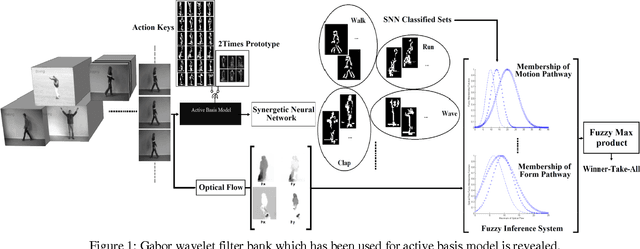
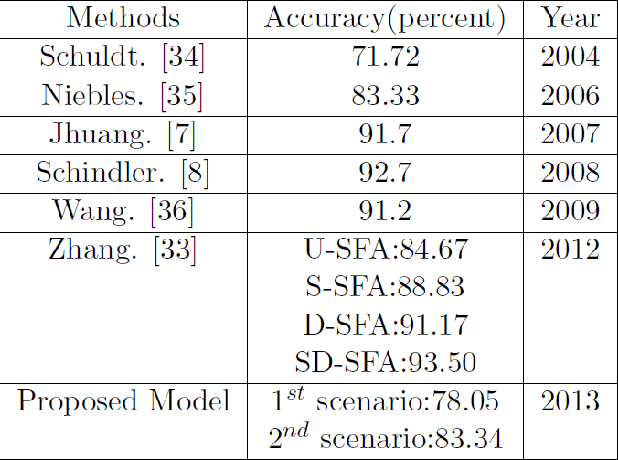
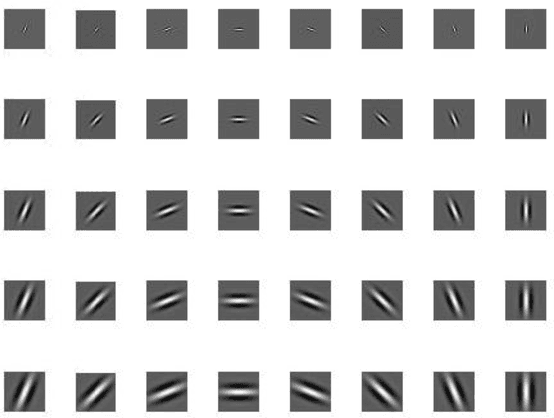
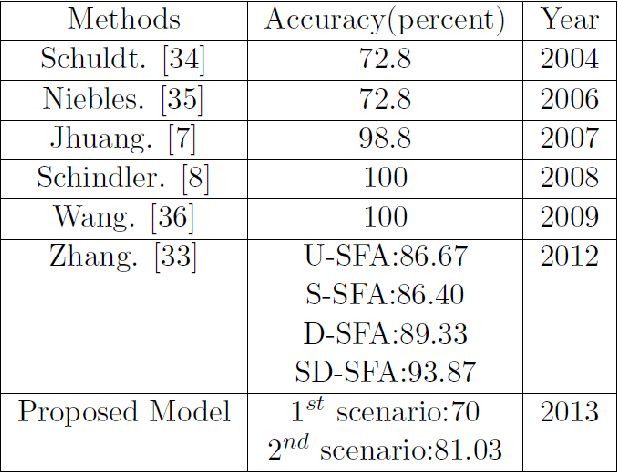
Abstract:Studies on computational neuroscience through functional magnetic resonance imaging (fMRI) and following biological inspired system stated that human action recognition in the brain of mammalian leads two distinct pathways in the model, which are specialized for analysis of motion (optic flow) and form information. Principally, we have defined a novel and robust form features applying active basis model as form extractor in form pathway in the biological inspired model. An unbalanced synergetic neural net-work classifies shapes and structures of human objects along with tuning its attention parameter by quantum particle swarm optimization (QPSO) via initiation of Centroidal Voronoi Tessellations. These tools utilized and justified as strong tools for following biological system model in form pathway. But the final decision has done by combination of ultimate outcomes of both pathways via fuzzy inference which increases novality of proposed model. Combination of these two brain pathways is done by considering each feature sets in Gaussian membership functions with fuzzy product inference method. Two configurations have been proposed for form pathway: applying multi-prototype human action templates using two time synergetic neural network for obtaining uniform template regarding each actions, and second scenario that it uses abstracting human action in four key-frames. Experimental results showed promising accuracy performance on different datasets (KTH and Weizmann).
A Dual Fast and Slow Feature Interaction in Biologically Inspired Visual Recognition of Human Action
Sep 12, 2015



Abstract:Computational neuroscience studies that have examined human visual system through functional magnetic resonance imaging (fMRI) have identified a model where the mammalian brain pursues two distinct pathways (for recognition of biological movement tasks). In the brain, dorsal stream analyzes the information of motion (optical flow), which is the fast features, and ventral stream (form pathway) analyzes form information (through active basis model based incremental slow feature analysis ) as slow features. The proposed approach suggests the motion perception of the human visual system composes of fast and slow feature interactions that identifies biological movements. Form features in the visual system biologically follows the application of active basis model with incremental slow feature analysis for the extraction of the slowest form features of human objects movements in the ventral stream. Applying incremental slow feature analysis provides an opportunity to use the action prototypes. To extract the slowest features episodic observation is required but the fast features updates the processing of motion information in every frames. Experimental results have shown promising accuracy for the proposed model and good performance with two datasets (KTH and Weizmann).
 Add to Chrome
Add to Chrome Add to Firefox
Add to Firefox Add to Edge
Add to Edge